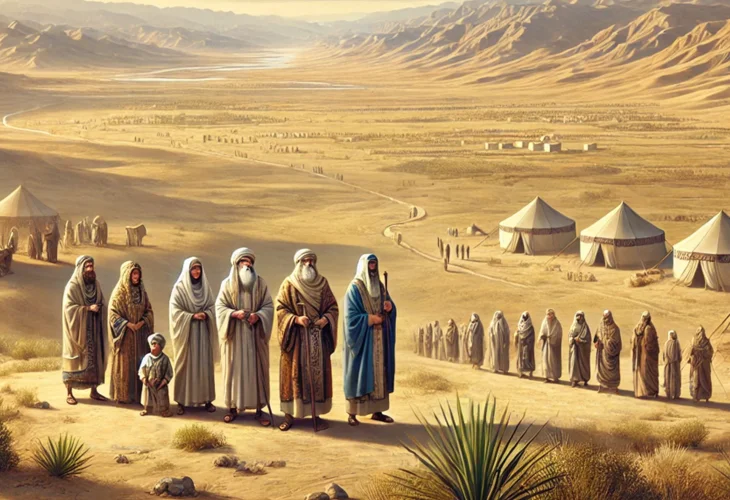The Mystery of Hadramaut: Unveiling Ancient Secrets
Among the descendants of Noah, one name stands out as intriguing and ominous: "And Joktan begot Almodad, Sheleph, and Hazarmaveth" (Genesis 10:26). Who was Hazarmaveth, and why does his name appear so foreboding?

Among the descendants of Noah, one name stands out as intriguing and ominous: "And Joktan begot Almodad, Sheleph, and Hazarmaveth" (Genesis 10:26). Who was Hazarmaveth, and why does his name appear so foreboding?
Hazarmaveth, known as Hadramaut, is a historical region in southern Arabia. Today it lies within Yemen, but ancient texts reference it as a significant hub on the "Incense Route," where merchants transported goods from the Far East to Mediterranean ports and beyond to Europe. Hadramaut was especially famous for trading frankincense and myrrh, and its name has endured through the ages, directly connecting it to its biblical origins. The language spoken there was known as "Hadramautic."
A midrash in Bereshit Rabbah offers a surprising explanation for the name. It states: "Rabbi Huna said: It is a place called Hazarmaveth, where they eat leeks and wear papyrus garments, expecting death daily. Rabbi Shmuel added that they do not even have papyrus garments."
Rabbi Huna first highlights that Hazarmaveth is not only a person's name but also the name of a place. He elaborates on the lifestyle of the inhabitants, detailing three aspects: their diet, "eating leeks"; their clothing, "wearing papyrus garments"; and their worldview, "expecting death daily." Rabbi Shmuel paints an even bleaker picture by adding, "they do not even have papyrus garments," emphasizing their extreme poverty.
The "Yafei Toar" commentary offers two supplemental explanations for the midrashic description. The first centers on material reality, depicting severe poverty and deprivation, with "expecting death" being seen as a direct result of such hardship. The second explanation delves into a deeper spiritual dimension, referring to people who focus on intellectual pursuits and choose not to engage in agriculture but live off what they find "prepared on the land," accepting their worldly insecurity as a conscious choice.
At the end of "Yafei Toar," Rabbi Mordechai Plungian (1814-1883) notes: "It may refer to the Troglodytes." Plungian, a prominent scholar of the Talmud and decisions at the Rabbinical Seminary in Vilnius and a chief proofreader at the Widow and Brothers Romm Press, combined deep Torah knowledge with broad historical insight. His brief note opens a window to a new historical understanding of the midrash.
The Troglodytes, whose name in Greek means "cave dwellers" (τρωγλοδύται), were extensively documented by Greek and Roman sources. From Herodotus in the fifth century BCE to Agatharchides in the second century BCE, and even Strabo and Pliny the Elder in Roman times, detailed accounts of this population exist. Ancient sources place the Troglodytes along the Red Sea and Arabian Peninsula, near the historical Hadramaut region.
Historical sources describe the Troglodytes' lifestyle in detail. They lived in caves, either natural or man-made, leading a life of minimalism. Their subsistence relied mainly on what they could gather naturally, with no organized agriculture. Their societal life was marked by extreme simplicity, minimal clothing, and a semi-nomadic way of life. Strabo particularly notes their unique approach to death and burial rites, viewing death as a natural and inevitable part of life and conducting distinct burial rites to reflect this belief.
Comparing the descriptions of the Troglodytes in ancient sources to the midrash reveals startling parallels. The midrash describes people "expecting death daily," an expression that aligns well with historical records of the Troglodytes' unique attitude toward death. The description of clothing in the midrash—"wearing papyrus garments" and even lacking those—corresponds to historical accounts of their extreme simplicity in attire. Additionally, the lifestyle described in "Yafei Toar," of people living off what they find "prepared on the land," matches descriptions of the Troglodytes' way of life.
Identifying the residents of Hazarmaveth with the Troglodytes helps resolve an intriguing historical paradox: How could an area like Hadramaut, known as a flourishing trade center on the ancient Incense Route, host a population characterized by poverty or asceticism? The answer lies in the fact that the Troglodytes lived on the fringes of organized society, even in regions that were major commercial hubs. They chose a different lifestyle, whether by choice or necessity, while maintaining unique cultural traits.
Plungian's suggestion to associate the residents of Hazarmaveth with the Troglodytes lends historical depth to the rabbinic teachings. It shows how the midrash, in its distinctive way, reflects documented historical realities. The interpretation "expecting death" is not just a commentary on the name, but describes a defining cultural feature of a recognized historical population. Moreover, this identification clarifies the two complementary explanations of "Yafei Toar"—both the emphasis on material poverty and the focus on spiritual asceticism, as both were known traits of Troglodyte society, as shown by historical sources.

